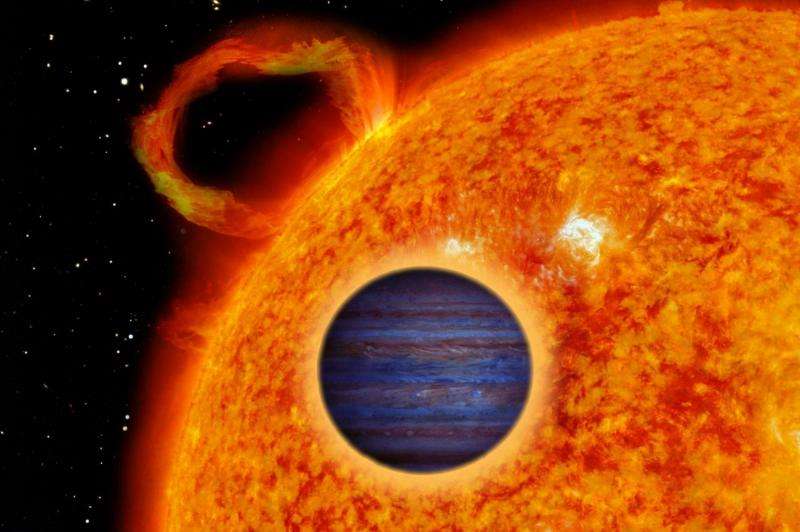February 16, 2016 report
Astronomers detect five new 'hot Jupiters'

(Phys.org)—Giant exoplanets, like the so-called 'hot Jupiters' that are similar in characteristics to the solar system's biggest planet and orbit very close to their host stars, are excellent targets for astronomers in their search for extrasolar worlds. The size and proximity of these planets is easy to detect as they create a large decrease in brightness when passing in front of their parent stars. Recently, an international team of researchers has announced a discovery of five new exoplanets, extending the catalogue of known 'hot Jupiters'. They published their findings in a paper published online on Feb. 4 in the arXiv journal.
The team, led by Pierre Maxted of the Keele University in Staffordshire, U.K., was looking for planet-like transits by using the Wide Angle Search for Planets-South (WASP-South) instrument—an array of eight cameras observing selected regions of the southern sky. The instrument, located at the site of the South African Astronomical Observatory (SAAO), outside Sutherland in South Africa, was used to study five stars showing planet-like transits in their light curve. To confirm the planetary nature of the observed targets, the researchers used photometry from the EulerCam instrument on the Swiss Euler 1.2-m telescope and the TRAPPIST telescope, as well as spectroscopy obtained with the CORALIE spectrograph—all installed at the La Silla Observatory in Chile.
The newly discovered planets were designated WASP-119 b, WASP-124 b, WASP-126 b, WASP-129 b and WASP-133 b. According to the paper, their masses range from 0.3 to 1.2 the mass of the Jupiter, with radii between one to 1.5 Jupiter radius, and their orbital periods vary from 2.17 to 5.75 days.
With a mass of 1.2 of the mass of Jupiter, and an orbital period of 2.5 days, WASP-119 b is a typical hot Jupiter. Its host star has a similar mass to the sun's but appears to be much older based on its effective temperature and density. WASP-124 b, less massive than Jupiter (0.6 Jupiter masses), has orbital period of 3.4 days and a much younger parent star.
WASP-126 b could be the most interesting for the scientists as its low surface gravity and a bright host star make the planet a good target for transmission spectroscopy. It is also the lowest-mass world found by Maxted's team.
"WASP-126b is the most interesting because it orbits the brightest star of the five. This means it can be a target for atmospheric characterization, deducing the composition and nature of the atmosphere from detailed study, for example with the Hubble Space Telescope or the forthcoming James Webb Space Telescope," Coel Hellier, one of the co-authors of the paper, told Phys.org.
Similar in size to Jupiter, WASP-129 b has the longest orbital period. Its surface gravity of this planet is also high compared to other known 'hot Jupiters'. WASP-133 b has the shortest orbital period of the exoplanets presented in the study. It is slightly bigger than the solar system's most massive planet (1.2 of Jupiter's mass and 1.2 of its radius).
Hellier noted that all of the planets described in the paper are based on detections of possible transit events from searching the accumulated WASP data. He underlines that WASP has been the most successful of the ground-based searches for transiting exoplanets. Only NASA's Kepler spacecraft has found more.
"We have a large program which combines data from the WASP-South survey search, which has been running continually for a decade now, with large amounts of time on the Euler/CORALIE spectrograph, plus large amounts of time on the TRAPPIST robotic photometer. Thus it does require a large and coordinated program to discover these transiting exoplanets. We have now found over 100, of which these five are the latest to be announced," he added.
The astronomers conclude that the planetary systems detected by them are good targets for follow-up observations with ground-based and space-based facilities to study their atmospheric and dynamical properties. They note that future exoplanet-hunting spacecraft like NASA's Transiting Exoplanet Survey Satellite could be very helpful in this field and could also detect more yet uncovered planets in these systems.
"TESS might find smaller transiting exoplanets in these systems, as the Kepler K2 mission did with our previous discovery WASP-47. TESS, however, will do this for nearly all WASP planets, whereas K2 is restricted to an ecliptic strip, and so can only look at a few WASP planets," Hellier said.
More information: Five transiting hot Jupiters discovered using WASP-South, Euler and TRAPPIST: WASP-119 b, WASP-124 b, WASP-126 b, WASP-129 b and WASP-133 b, arXiv:1602.01740 [astro-ph.EP] arxiv.org/abs/1602.01740
Abstract
We have used photometry from the WASP-South instrument to identify 5 stars showing planet-like transits in their light curves. The planetary nature of the companions to these stars has been confirmed using photometry from the EulerCam instrument on the Swiss Euler 1.2-m telescope and the TRAPPIST telescope, and spectroscopy obtained with the CORALIE spectrograph. The planets discovered are hot Jupiter systems with orbital periods in the range 2.17 to 5.75 days, masses from 0.3MJup to 1.2MJup and with radii from 1RJup to 1.5RJup. These planets orbit bright stars (V = 11-13) with spectral types in the range F9 to G4. WASP-126 is the brightest planetary system in this sample and hosts a low-mass planet with a large radius (0.3 MJup , 0.95RJup), making it a good target for transmission spectroscopy. The high density of WASP-129 A suggests that it is a helium-rich star similar to HAT-P-11 A. WASP-133 has an enhanced surface lithium abundance compared to other old G-type stars, particularly other planet host stars. These planetary systems are good targets for follow-up observations with ground-based and space-based facilities to study their atmospheric and dynamical properties.
© 2016 Phys.org




















